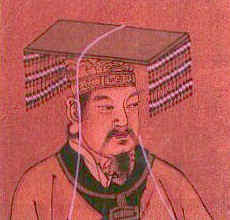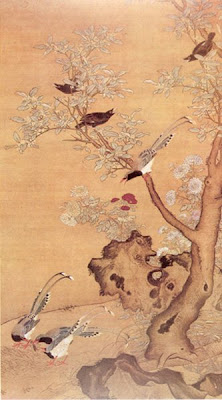
[Haung-Ti with a nice hat!]
Huang-Ti, or the Yellow Emperor, was a legendary Chinese sovereign and cultural hero who is considered in mythology to be the ancestor of all Han peoples. One of the legendary Five Emperors, it was written in the Shiji by historian Sima Qian (145 BC-90 BC) that the Huang-Ti reigned from 2697 BC to 2598 BC (pre-dating China's earliest Shang Dynasty, c. 1766-1122 BC). He emerged as a chief deity of Taoism during the Han Dynasty (202 BC-220 AD). The legend of his victory in the war against Emperor Chi You at the Battle of Zhuolu is seen as the establishment of the Han Chinese nationality.

Ling Lun (his name meaning "musician" and "to measure") was sent by Huang-Ti, in the first year of his reign, to the western mountains to cut bamboo pipes (lu) from which fundamental pitches could be made. The Chinese found (as did the Ancient Greeks) that 12 distinct pitches could be generated -- some more and some less in tune to modern ears. Indeed, an infinite number of pitches can be generated, but eventually the ear cannot distinguish the microtonal differences. The Chinese, via a system of pitches generated by fifth relations, had 365 pitches -- one for each day of the year!

In legend, Ling Lun gave the emperor flutes tuned to the sounds of birds, which is said to be the foundation of Chinese traditional music.
[China - Autumn Moon (ensemble music)]
Chinese flutes come in various types. They include
Dizi (and its varieties such as the bangdi; all transverse flutes, usually made of bamboo)
Xiao (end-blown vertical bamboo flute)
Gudi, an ancient vertical flute made from the bones of large birds
Paixiao (pan pipes)
Koudi (a very tiny bamboo flute)
Xun (clay ocarina)
Chinese flutes are generally made from bamboo and belong to the bamboo classification of Chinese music, although they can be (and have been) made of other materials such as jade.
[4214 Egyptian Old Kingdom / 4303 Hung-ti / 4200 I Ching Ch'in
